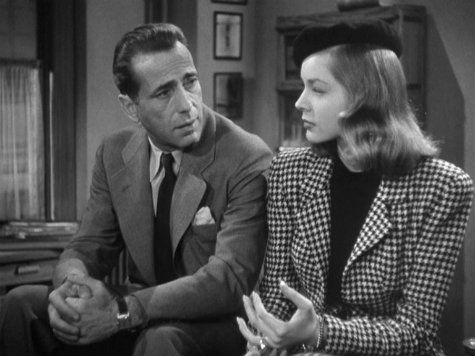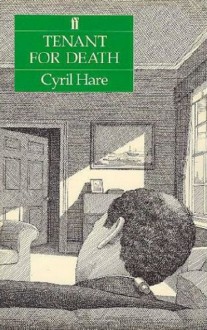

They were one of Hollywood's all-time legendary couples, both on screen and off; producing celluloid magic in the four films they made together between 1943 and 1948 as much as by their off-screen romance, which in itself was the stuff that dreams are made of. He was the American Film Insititute's No. 1 star of the 20th century, Hollywood's original noir anti-hero, who in addition to the AFI honors bestowed on his real-life persona also played two of the 20th century's Top 50 film heroes (Casablanca's Rick Blaine and this movie's Philip Marlowe); epitome of the handsome, cynical and oh-so lonesome wolf, looking unbeatably cool in dinner jacket, trenchcoat and fedora alike, a glass of whiskey in his hand and cigarette dangling from the corner of his mouth; and endowed with a legendary aura several times larger than his physical stature. She, despite a 25-year age difference his equal in everything from grit and toughness to mysterious appeal; chillier than bourbon on the rocks, possessing more than just a touch of class whatever her role; and long since a bona fide AFI movie legend in her own right.
Humphrey Bogart and Lauren Bacall met on the set of Howard Hawks's 1944 realization of Ernest Hemingway's To Have and Have Not, where an obvious chemistry quickly developed between 45-year-old veteran Bogart, who had just scored two of film history's greatest-ever hits with The Maltese Falcon and Casablanca in the two preceding years, and the sassy, exciting 20-year-old newcomer who possessed the maturity and sex-appeal of a woman good and well 10 years her senior. They were reunited two years later for this adaptation of Raymond Chandler's first Philip Marlowe novel (published 1939), based on a screenplay written, like that of To Have and Have Not, by William Faulkner and Jules Furthman, together with Leigh Brackett (who had not participated in scripting the Hemingway adaptation). By the time the movie was released in 1946, Bogart and Bacall were married.
Reprising Bogart's noir gumshoe role with a character not unlike Dashiell Hammett's Sam Spade in The Maltese Falcon, the movie The Big Sleep is as infamous as Chandler's literary original for its labyrinthine plot, which reportedly even the author himself couldn't completely untangle (nor did he care to). The action is essentially faithful to that of Chandler's novel, from which it also takes much of its dialogue; albeit streamlined and with some changes made to fit Bogart's physical characteristics, and eliminating or softening a few scenes considered unfit for display to a moviegoing audience in the 1940s. The story begins when Marlowe is hired by wealthy old General Sternwood to handle a blackmailing attempt involving gambling debts incurred by Sternwood's younger daughter Carmen (Martha Vickers) (whom the detective has already met when she literally threw herself into his arms upon his entry into the house, sucking her thumb and coyly telling him "you're cute"). After his interview with the dying general in the latter's hot and humid orchid house, a disheveled Marlowe is summoned to the rooms of the general's older daughter Vivian (Lauren Bacall), who tries to worm out of him the purpose of his engagement and who, as Marlowe quickly concludes, has more than a minor hidden agenda of her own. Soon the detective is up to his ears in the classical film noir brew of murder, damsels in distress, shady characters and a world where nothing is what it appears to be, and where he'll be able to consider himself lucky if he gets out alive – yet, he is determined to see the case through and will neither be bought off by money nor by sweetness and seduction.
Looking back at the movie and its stars' almost mythical fame, it is difficult to imagine that, produced at the height of the studio system era, it was originally just one of the roughly 50 movies released by Warner Brothers over the course of one year. But mass production didn't equal low quality; on the contrary, the great care given to all production values, from script-writing to camera work, editing, score (Max Steiner) and the stars' presentation in the movie itself and in its trailer was at least partly responsible for its lasting success. Indeed, the release of The Big Sleep was delayed for an entire year – and not only because its first version was completed around the end of WWII and Warner Brothers wanted to get their still-unreleased war movies into theaters first, but also, and significantly, because Lauren Bacall's agent convinced studio boss Jack Warner and director Howard Hawks to reshoot several scenes to better highlight the sassy, mysterious new star Bacall had become after To Have and Have Not. And it certainly paid off: The Big Sleep firmly established then-22-year-old Lauren Bacall as one of Hollywood's new leading ladies, and even more than her first film with Humphrey Bogart laid the foundation for the couple's mythical relationship.
Bogart and Bacall would star together two more times after this movie: In Dark Passage (1947) and Key Largo (1948). But of their four collaborations, the first two – and in particular, The Big Sleep – remain unparalleled for their secretive, shadowy aura, tight scripting, snappy dialogue, cynicism and underlying seductiveness; due in equal parts to the story crafted by Raymond Chandler, its adaptation by Faulkner, Furthman and Brackett, Howard Hawks's masterful direction, and its starring couple's irresistible chemistry. After three failed marriages, after having produced on-screen magic with Mary Astor in The Maltese Falcon and, even more so, with Ingrid Bergman in Casablanca (and although he would go on to star in such memorable pairings as next to Katherine Hepburn in The African Queen and Audrey Hepburn in Sabrina), Humphrey Bogart had finally met his match – and while his and Bacall's marriage was painfully cut short by the cancer to which he succumbed in 1957, the magnetism they created on screen will live on, and nowhere more brilliantly than in The Big Sleep.
(Original version of this review posted on ThemisAthena.info. To mark Lauren Bacall's passing, also cross-posted on Leafmarks.)



 Log in with Facebook
Log in with Facebook 













